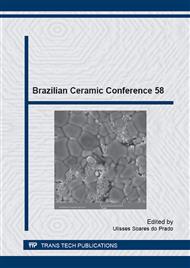p.3
p.8
p.13
p.18
p.24
p.30
p.36
p.40
Performance of Precursor Materials and Fired Ceramics for Structural Blocks
Abstract:
The physical, chemical and mineralogical characterization of a precursor clay body before firing is of relevance for understanding the technological performance of the fired clay ceramic. In particular, structural clay ceramic blocks used in building construction need to attend standard properties specified by the norms. In the present work the precursor clay body, typically used to fabricate structural blocks in Campos dos Goytacazes, state of Rio de Janeiro, Brazil, was characterized in terms of particle size distribution, X-ray diffraction, chemical composition and Atterberg limits. In addition, the performance of structural ceramic blocks, fabricated from the extruded clay body and fired at 850oC, was evaluated. The results indicated that the ceramic mechanical strength complies with the Brazilian norm but the water absorption is higher than the maximum specified by the norm. The characteristic of the clay body contribute to justify the structural blocks performance.
Info:
Periodical:
Pages:
13-17
Citation:
Online since:
June 2015
Price:
Сopyright:
© 2015 Trans Tech Publications Ltd. All Rights Reserved
Share:
Citation:


